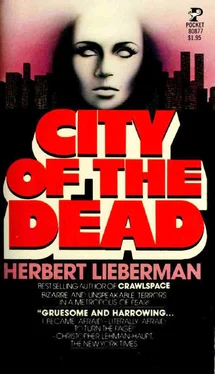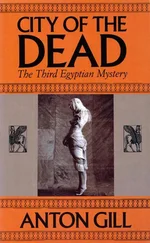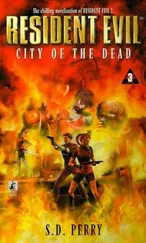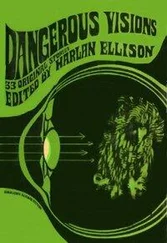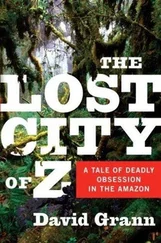Konig descends now to the autopsy rooms, going down a steel spiral stairway into green glowing light. Down out of long green corridors he drops. Aquarium green. Municipal green. Bureaucratic green. Green moist tiles—freezing in winter, sweating in summer. Down into a soft green diffusion—the netherworld of First Avenue. Past the Acheron of a dozy guard, across the Styx of the iron anteroom gate, moaning open, clanging shut behind him. The gong of heavy steel doors reverberating through cavernous green-tiled tunnels.
Down he goes, still descending, yet another short flight of stairs, the slow, slurred click of his slightly limping tread pinging oft’ the ceilings and walls. Another gate squeals open, gongs shut behind him, and he is now in the deeper green of the subbasement level. The air is heavy with the thick, fumy vapors of formaldehyde.
There is a curious smell to an autopsy room. Death and asafetida. Formalin and fright. Once you’ve smelled it, you never forget it. The odor—almost forty years’ worth—so much a part of Konig’s being that he is no longer aware of it. It imbues his clothing, his skin, his hair. His car smells of it and his closets at home. When his wife was alive, she wouldn’t permit him to come near her until he’d showered.
Konig now enters a gray cool area filled with the high-pitched electrical whir of refrigerator motors. Already lined up on his left, a number of stainless-steel trolleys, each bearing a lumpen, belted canvas sack—a grim succession of the night’s harvest of victims. There is a whole wall of refrigerator compartments running from floor to ceiling, temporary repositories for the unclaimed, the anonymous, the unwanted. Known often just by numbers, the stiff, formal impersonality of two and three digits, here the dead lie, all left to the cold impartiality of separate drawers. All awaiting the pathologist’s blade.
Konig drops down a final three steps, pushes open swinging doors and enters a bright white glow. Here, green-robed attendants shuttle back and forth on padded feet—hooded acolytes in some ancient druidical rite. Konig moves past steel pans of cirrhotic livers, a diseased lung gurgling in a tub of formalin. Each time Konig makes this descent, each time he enters this abattoir, this charnel house fuming with the ever-thickening waves of stench, his whole being is suffused with the curious, yet somehow entirely befitting notion that he has once again come home.
Already the place is a hive of activity—twelve tables going all at once. Cadavers naked, flayed open, sectioned. Unreal-looking things. The organs opened, exposed, give the appearance of wax fruits.
A great din and hum of human enterprise animates this autopsy room. It could be the production loft of a prosperous dress manufacturer, the tailors all bent and busy over their tables.
Here are the pathologists, cutting, weighing, evaluating; and the police stenographers, scribbling dictation from them onto their pads. The young medical students hovering around the various tables’, asking questions. The scrubbers—dieners they call them—sewing up the cadavers with large needles and black thread after the pathologists have finished. A strange breed of men, these. One there in particular, a small, dark, recently naturalized Albanian with furtive eyes and scarcely any English, Konig watches uneasily, knowing him to be one who liked to handle young female cadavers, liked to undress them, prepare them for cutting. Then would linger over the flayed carcass, long after the autopsy was completed and everyone else had gone, ostensibly sewing it up.
And then, of course, the cadavers, twelve of them lined up on steel tables—the objects of the quest. Here, a black man, throat slashed from ear to ear, laryngeal cartilage glinting from the gaping wound, flashes a death grin. On the table beside him, an ancient, wizened little lady, with dainty hands and feet, somewhat beyond eighty. Body shrunken, oddly childlike, face blue with cyanosis, the sparse, frizzled pubic hair of a child, she seems to be gazing upward at heaven. She’d been hammered to death and robbed of sixty cents in a welfare hotel room the night before.
A little farther down, a bedraggled itinerant with a huge halo of gray hair encircling the face of a saint. He’d been martyred in a doorway on Canal Street. Then two homicides—undoubtedly two of Flynn’s half dozen of the night before—three gunshot wounds, a stabbing through the throat and a fatal garroting. Then a beautiful young girl, with the features and lineaments of a fashion model, dead of barbiturates at twenty-two. After her, a drowned black prostitute who’d been in the water several days, her hair separated from the scalp so that it could be lifted off like a cap. White froth bubbles from her nose and the body is swollen from distention of the tissues with gas.
There are few things that can be hidden from the pathologist. But at that point there’s no longer any need to hide. The reasons for hiding have all been eliminated. The only questions that remain are academic. The pathologist stands before the flayed and naked corpse like an old shaman reading auguries in the viscera of sacrificial sheep.
“Emboli in left coronary artery.”
“Aortic incompetence. Ascending aorta dilated with longitudinal rugae on the intima.”
“Liver enlarged with gross fatty change.”
“Testes, 30 grams.”
“Rectal lesions—rectum markedly dilated, containing fresh semen.”
No further need for shame or disguise. Shame seems such an empty gesture at this point. It is all written there clearly for the pathologist to read, as if the organs were a kind of papyrus upon which the foolish hieroglyphics of our lives are scrawled.
Beneath the cool white glare of overhead fluorescents, Konig pauses to watch Arthur Grimsby, a young assistant, remove the calvaria of what was once a male Caucasian, approximate age forty to forty-five, blood type O+. A jeweler shot to death in his shop on Delancey Street.
The saw buzzes and particles of hair and bone whir off its blade in a pretty lariat.
“Neat,” Konig murmurs as young Grimsby’s hand severs the medulla and cranial nerves preparatory to removal of the brain.
Already the Chiefs gray, avid eyes have spied the point of entrance of the bullet. It is at the forehead and just beneath the hairline. Long before Grimsby, he has spied the point of exit at the back of the head, as well as the route the bullet has taken in between. He has a fairly good idea from the powder burns on the skin at what distance the pistol was fired, and from the angle at which the bullet entered the skull, something of the position in which the jeweler met his end.
Grimsby extracts several fragments of the bullet with a prong, plucking them out and holding them up to the light like rare gems, for all to see.
“Neat,” Konig murmurs again. “Careful you don’t mess those bullet tracks.”
The Chief always pauses for the children. He doesn’t want to, he simply has to. It is a compulsion of his, a rather sick one he has concluded, since he knows that there is literally nothing more he can learn from contemplating such pathetic spectacles. He has seen so many in his day. They all tell the same dismal story. But, still, in nearly forty years of practice, of seeing the most grisly testimony to man’s inexhaustible genius for cruelty, he has never quite been able to steel himself to the sight of a battered child. When the job is done well, as so frequently it is, it is truly an awesome sight to contemplate.
The one he is looking at now, mauled and beaten beyond recognition, is a toddler. No more than two or so, and the facial features have literally been erased by the use of some heavy, blunt instrument.
Seeing the ragged, broken little shape on the table, Konig suddenly has a vision of his own daughter, Lolly—Lolly as a child at the seashore, toddling toward him with a shovel and a sand pail upon which enamel dolphins gambol; Lolly in the mountains, a brash little girl astride a dun mare; Lolly on her first trip abroad, a sere and yellowed photograph, frayed with age, showing a smiling ten-year-old perched on the taffrail of a French passenger liner.
Читать дальше
